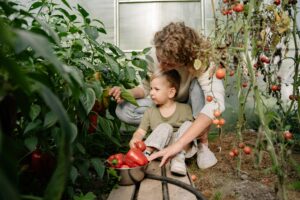Essential Life Skills for Homeschoolers: Teaching Budgeting, Cooking & More at Home
Why Life Skills Belong in Homeschooling
Ask most adults what they wish they’d learned in school, and the answer is rarely calculus. Instead, they often say: “I wish someone had taught me how to budget my money, cook a real meal, or change a flat tire.”
This gap in education is where homeschooling shines. Parents have the freedom to go beyond traditional academics and weave real-life skills into their daily routines. Teaching these practical lessons not only prepares children for adulthood but also builds confidence, independence, and resilience.
In this guide, we’ll explore the top life skills every homeschool parent should include in their curriculum, along with hands-on activities, resources, and strategies for making them fun and effective.
Why Life Skills Matter in Homeschooling
- Schools rarely cover them: Public schools often focus on standardized tests and core academics, leaving little time for personal finance, cooking, or basic maintenance.
- They build independence: Children who can manage their money, cook, and organize their time are better prepared for life after high school.
- They support academics: Budgeting ties to math, cooking ties to science, and planning ties to literacy and critical thinking.
- They prepare for adulthood: From college dorm life to managing a household, life skills help teens transition smoothly into independence.
Homeschool parents can give their kids an advantage by designing a curriculum that balances academics and real-world learning.
The Top Life Skills Every Homeschooler Should Learn
1. Money Management & Budgeting
Financial literacy is one of the most requested life skills among homeschooling parents—and for good reason. Studies s
how that most teens graduate high school with little knowledge of how to budget, save, or use credit responsibly.
What to Teach:
- Difference between needs vs. wants
- Saving, giving, and spending principles
- How to make a budget and stick to it
- Basics of credit, debt, and interest
Hands-On Activities:
- Give your child an allowance and guide them in dividing it into “Save, Spend, Give” jars.
- Let older kids plan a family grocery trip with a set budget.
- Play money-themed board games like Monopoly or The Game of Life.
Tools & Resources:
- Apps: Greenlight, BusyKid, FamZoo
- Free resources: Next Gen Personal Finance, Khan Academy’s personal finance lessons
2. Cooking & Nutrition
Knowing how to cook is about more than making food it’s about health, independence, and creativity. Plus, cooking is a natural way to integrate math (measuring), science (chemical reactions), and health education.
What to Teach:
- Reading recipes and following steps
- Basic cooking methods (boiling, sautéing, baking)
- Nutrition and balanced meals
- Food safety and kitchen hygiene
Hands-On Activities:
- Younger kids: make sandwiches, smoothies, or scrambled eggs.
- Older kids: plan and cook a full family dinner once a week.
- Connect cooking to culture explore meals from different countries.
Tip: Start a “Family Cookbook Project” where your child records recipes they’ve mastered.
3. Home & Car Maintenance
Many adults admit they didn’t know how to unclog a drain or change a tire until well into adulthood. Giving kids these skills early builds confidence and responsibility.
What to Teach:
- Household basics: laundry, sweeping, cleaning bathrooms, simple repairs
- Safety: how to use tools properly
- Car basics: checking oil, pumping gas, changing a tire
Hands-On Activities:
- Weekly “Fix-It Friday” where you tackle one new skill: hanging a picture, tightening a screw, or changing an air filter.
- Car lessons: practice checking tire pressure and refilling windshield wiper fluid.
Bonus Idea: Create a family “Home Maintenance Binder” that includes checklists and seasonal tasks your child can help track.
4. Time Management & Organization
In today’s busy world, knowing how to manage time is as important as academics. Homeschooling gives kids the chance to practice scheduling and responsibility.
What to Teach:
- How to use a planner or digital calendar
- Prioritizing tasks
- Breaking projects into smaller steps
- Setting realistic goals
Hands-On Activities:
- Have your child plan the family’s weekend schedule.
- Use visual chore charts for younger learners.
- For teens, try productivity apps like Trello or Google Calendar.
5. Communication & Social Skills
Strong communication helps kids thrive in school, work, and relationships. Homeschooling offers space to practice speaking, listening, and writing in real-world contexts.
What to Teach:
- Phone and email etiquette
- Writing letters and resumes
- Public speaking and active listening
- Conflict resolution
Hands-On Activities:
- Role-play a job interview.
- Have your child make a phone call to order food or schedule an appointment.
- Encourage journaling or blogging to practice written communication.
6. Critical Thinking & Problem-Solving
Life requires the ability to evaluate situations, think logically, and solve problems under pressure.
What to Teach:
- How to evaluate online information for credibility
- Decision-making strategies
- Creative problem-solving
Hands-On Activities:
- Debate current events around the dinner table.
- Solve logic puzzles, riddles, or escape room-style games.
- Present real-life scenarios: “What would you do if the power went out for 24 hours?”
7. Health & Wellness Basics
Good health habits start early and set the stage for lifelong wellness.
What to Teach:
- Hygiene: brushing teeth, handwashing, laundry
- Fitness and daily movement
- Nutrition and hydration
- Basic first aid (CPR, treating burns, cuts, fevers)
Hands-On Activities:
- Family walks or workout challenges
- Teach your child how to use a first aid kit
- Let them schedule their own annual checkup
8. Civic Responsibility & Community Engagement
Raising responsible citizens is just as important as raising good students.
What to Teach:
- How local government works
- Basics of voting and civic duty
- Volunteering and community service
Hands-On Activities:
- Visit a town hall meeting.
- Volunteer at a local food pantry.
- Create a family “giving project” once a year.
How to Build a Life Skills Curriculum in Your Homeschool
- Start with age-appropriate goals – elementary kids learn chores and basic safety, while teens take on budgeting and independent cooking.
- Blend skills into existing subjects – budgeting = math, cooking = science, journaling = writing.
- Use project-based learning – run a lemonade stand, plan a family vacation, or manage a weekly budget.
- Create a weekly “Life Skills Day” – dedicate one day or afternoon each week to real-world learning.
Resources & Tools for Parents
- Books:
- Life Skills for Kids by Christine Field
- The 7 Habits of Highly Effective Teens by Sean Covey
- Websites & Courses:
- Khan Academy (finance & math)
- YouTube (cooking, repairs, DIY tutorials)
- Apps:
- Trello (organization)
- Evernote (note-taking)
- Greenlight (budgeting for kids)
- Freebie Idea for Blog Readers: Downloadable “Homeschool Life Skills Checklist”
Preparing Kids for the Real World
Homeschooling gives parents a unique opportunity to raise children who are not only academically prepared but also ready for real life. From budgeting to cooking, car maintenance to civic engagement, these lessons provide confidence and independence that traditional schools often overlook.
Start small pick one new skill each week and watch your child’s competence and independence grow.




